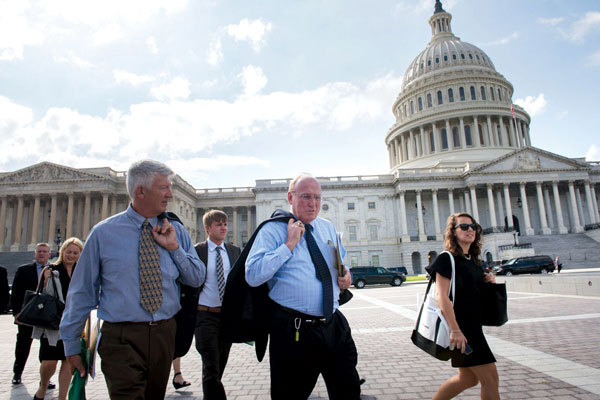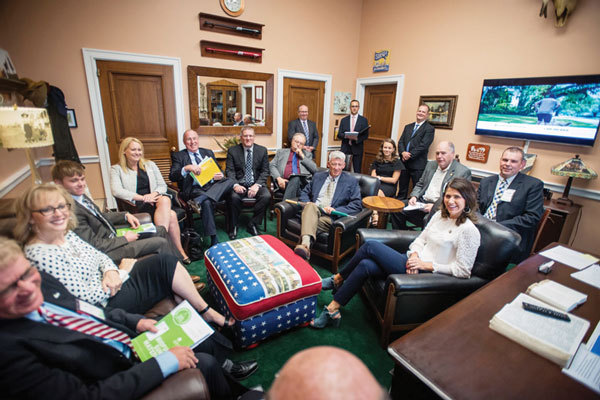The Fundamentals of Fly-Ins





PHOTO: iSTOCK
January 19, 2018
BY Keith Loria
Getting the ear of members of Congress, state legislators or regulatory bodies is not always easy. So many of the ethanol industry’s top groups and organizations participate in Washington, D.C., fly-ins, which provide an opportunity to engage lawmakers and regulators directly.
“All lawmakers need to have a good understanding of what the biofuels industry is and the important role it plays in America’s overall economy,” says John Fuher, senior director of government affairs for Growth Energy. “It is up to our industry to make sure that lawmakers are well educated on policies and legislation because their vote and position on the issue can greatly influence the outcome of a bill.”
Shannon Gustafson, senior director of operations and programming at the American Coalition for Ethanol, is charged with organizing the group’s annual Washington, D.C., fly-in. She says the event is vital.
“Personal stories go a long way on Capitol Hill,” she says. “Members of Congress and staff will take note of a visitor who travels the long distance to Washington, contributing personal time and expense to a cause. These events develop relationships between Hill staff and fly-in participants, so when a bill comes up in the future, the staff will know where to go for accurate information.”
Those invited to fly-ins range from representatives from ethanol plants, biofuels associations, corn grower associations, businesses that provide the equipment and supplies for ethanol plants, and more. Essentially, anybody who supports the biofuels industry is invited to attend.
‘Awesome Opportunity’
At its fly-in, an organization first gathers all its members and participants to review the top legislative priorities, then chooses a variety of speakers who have expertise in certain issues, says Roger Berry, director of market development for the Nebraska Corn Board.
“After this orientation period, the participants break into smaller groups and make visits to the members on the Hill,” he says. “In my opinion, this is the best part of a D.C. fly-in. We have an awesome opportunity and responsibility to make sure our lawmakers are hearing all sides of the issues they will be debating and voting on.”
After the Hill visits, participants gather again to learn about other topics pertinent to the ethanol industry and to explore future issues and goals.
In September, the National Farmers Union hosted more than 300 of its 200,000 members at its annual fall fly-in, advocating for expanded use of ethanol. “They came in to engage with members of the administration, and to meet with their members of Congress to talk about the state of the farm economy, expanding use of ethanol and advanced biofuels, and health care,” says Roger Johnson, NFU president. “With respect to Congress, our members asked lawmakers to continue to support a strong RFS and to eliminate current barriers to use of higher-blended ethanol in gasoline.”
Fuher and Gustafson say topics during Capitol Hill meetings during a fly-in could include the Renewable Fuel Standard, Reid vapor pressure, octane, low carbon benefits of ethanol, benefits to rural economies and success stories of retailers who offer blends higher than E10.
“We also walk participants through the logistics of attending Hill meetings, getting around Congressional offices, how to approach a meeting with staff or a member of Congress, and how to divide the work among team members,” Gustafson says. “We invite speakers from the regulatory side of things—someone from EPA, for example—to come meet with our group because so many of our priority issues are being handled by the executive branch.”
Ripple Effect
While Growth Energy always has its members meet with lawmakers from their home states, the group also requests that they meet with lawmakers who might not be familiar with the biofuels industry and its priority issues. “Every lawmaker can benefit from hearing from our members, because their vote and support, along with our Congressional champions, can go a long way and make a huge difference in passing beneficial legislation for our industry,” Fuher says.
Bob Hemesath, past president of the Iowa Corn Growers Association, regularly attends lobbying meetings and was at Growth Energy’s fly-in in September. “We spend a lot of time with noncorn-state legislatures and let them know what we’re after and the reasons behind it. It’s also important to see what questions they have and need more clarification on.”
Even states outside the Corn Belt benefit directly from policies such as the RFS, or RVP relief.
“Consumers across the country benefit from lower prices at the pump, a lessened reliance on fossil fuels, and from breathing cleaner air,” Gustafson says. “It’s important for lawmakers to understand the ripple effects policies like the RFS have across the country because we simply don’t have enough votes by relying upon the Corn Belt alone.”
Lawmakers need to hear from their constituents, Johnson says, and there is no better way to do that than face-to-face interaction. “They learn, as we all do, from stories and experiences, and messages straight from the farmer go a long way in moving the needle, if the needle is able to be moved,” he says. “I’m not sure it’s much different from educating consumers, as both have very limited amounts of time to take in and retain information. If there is a difference, it is that lawmakers are more influenced by public perception. If you can demonstrate farmers and ranchers care enough to take time out of their busy schedules to fly or drive to Washington, they are going to take the time to visit the ballot box in November.”
Fuher says lawmakers value hearing directly from their constituents about certain policies and legislation that are either harmful or beneficial to their businesses or communities back home.
“A meeting between a lawmaker and the constituents they represent is far more impactful and effective than hearing from an everyday lobbyist in Washington,” he says. “Advocating for policies that are in the best interest of our businesses, communities and states is a critical part of the political process.”
Author: Keith Loria
Freelance Journalist
freelancekeith@gmail.com
Advertisement
Advertisement
Advertisement
Advertisement
Related Stories
The U.S. Energy Information Administration maintained its forecast for 2025 and 2026 biodiesel, renewable diesel and sustainable aviation fuel (SAF) production in its latest Short-Term Energy Outlook, released July 8.
XCF Global Inc. on July 10 shared its strategic plan to invest close to $1 billion in developing a network of SAF production facilities, expanding its U.S. footprint, and advancing its international growth strategy.
U.S. fuel ethanol capacity fell slightly in April, while biodiesel and renewable diesel capacity held steady, according to data released by the U.S. EIA on June 30. Feedstock consumption was down when compared to the previous month.
XCF Global Inc. on July 8 provided a production update on its flagship New Rise Reno facility, underscoring that the plant has successfully produced SAF, renewable diesel, and renewable naphtha during its initial ramp-up.
The U.S. EPA on July 8 hosted virtual public hearing to gather input on the agency’s recently released proposed rule to set 2026 and 2027 RFS RVOs. Members of the biofuel industry were among those to offer testimony during the event.
Upcoming Events










